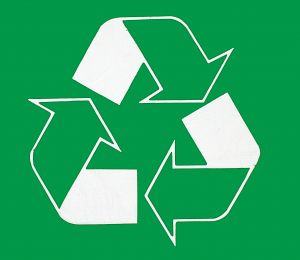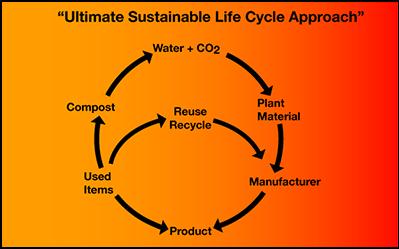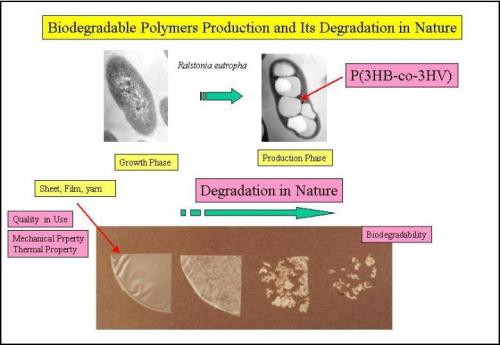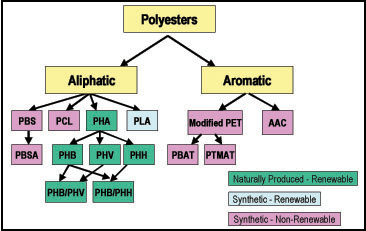Sustainable packaging, packaging
waste reduction and development of biodegradable plastics for packaging –
means to promote cleaner environment:



(iv) These features can be seen in the structures of some degradable polymers that are already in use.

Packaging is used in business to contain and
promote finished products for consumer sales and also to transport them
to the point of sale safely. The function of packaging includes
protecting products in shipping, offering consumers information,
providing a branding billboard and giving us a way to carry things home.
The most commonly used packaging materials are paper, fiberboard,
plastic, glass, steel and aluminum.

A. High proportion of waste is actually packaging -
Innovative packaging design can mean that the
amount of materials used is reduced and that all packaging can be
reused or at least recycled. In other words, it is nothing but creating
more ‘sustainable packaging’. Using the minimum and most efficient
packaging will increase your competitiveness and save you money, as well
as attracting environmentally-aware consumers.
Fortunately, everyone from the retail
behemoth Wal-Mart to start-up companies and boutique design shops are
beginning to look for ways to reduce the volume of stuff we throw away.
However, even the most green-sympathetic designer will quickly find
there are no easy answers or quick fixes when it comes to sustainable
packaging. Even defining the term poses difficulties.
B. ‘What’s a sustainable package?’ –
Now, the question becomes not how to do away
with packaging, but how to use less of the less-harmful materials. To
become more sustainable, designers must consider and improve each step
along the entire product journey. Packaging, like any other design
problem, will need to be rethought with a sustainable systems approach.
Designers should expand and evolve creative processes to include
strategies like
(a) optimizing material and energy resources;
(b) sourcing materials that are produced responsibly with environmental best practices, fair labor and trade;
(c) choosing materials that are nontoxic, bio-based and made from renewable resources; and
(d) designing for resources recovery or reintegration back into nature after end use.
C. Sustainability criteria for packaging -
1. Is beneficial, safe and healthy for individuals and communities throughout its lifecycle;
2. Meets market criteria for performance and cost;
3. Is sourced, manufactured, transported and recycled using renewable energy;
4. Maximizes the use of renewable or recycled source materials;
5. Is manufactured using clean production technologies and best practices?
6. Is made from materials healthy in all probable end-of-life scenarios;
7. Is physically designed to optimize materials and energy;
8. Is effectively recovered and utilized in biological and/or industrial cradle-to-cradle cycles.

D. The “5 Rs” of creation of sustainable package –
Designers dedicated to fostering environmental sustainability—offer some practical advices:
Restore by using materials and supporting firms that reduce or improve our natural capital;
Respect what we have by examining all the impacts that packaging may have;
Reduce the amount of materials, layers of packaging, weight of package, fuel used in transport, etc.;
Reuse something that’s already been made, and make your package easy and desirable to reuse; and
Recover the materials used through recycling, composting or reusing.
One of the most important and simple ways a
designer can move beyond conventional packaging solutions is to consider
alternative materials. PLA (polyactic acid) is fast becoming the
favored alternative to plastic. PLA is made from renewable resources
such as corn, and uses fewer fossil fuels and generates fewer greenhouse
gases in its production than traditional plastics and some other
polymers. PLA can be composted as well. Fortunately, other materials are
also coming to commercial viability.
E. The increase
in online shopping has meant a rise in goods being delivered direct to
customers’ homes. This means that more packaging is needed to supply the
goods. You can encourage customers to return your packaging to you for
reuse by supplying them with a “freepost” return label.
F. Other ways of improving packaging use are:
(i) Using recycled materials where possible;
(ii) Designing the packaging using the least amount of materials necessary;
(iii) Reusing your own packaging to create new packaging or in other areas of your business.
G. Bio-degradable plastics for packaging – development and use are the key for improvement of environment:
There is growing concern about the excess use
of plastics, particularly in packaging. In response to problems
associated with plastic waste and its effect on the environment, there
has been considerable interest in the development and production of
biodegradable plastics.

a. At present,
we make almost 100% of plastics of our requirement from oil and natural
gas. Petroleum-based plastics are basically non-degradable. As concern
grow about the potential bad effects of petroleum-based non-degradable
plastics on the environment, the viability of petroleum-based plastics
are in question. At the same time, the increased dependence on oil and
gas imports due to manufacture of such petroleum-based products, make us
think about the possible solution. In this respect, searching for
suitable degradable polymers for various applications as per the need,
have become very important aspect in today’s science and technological
affair for research.
b. As per
reports of various environment protection agencies, plastics alone
account for more than 25% (by volume) of municipal waste generated.
Plastic’s low density and slowness to decompose makes them a visible
pollutant of public concern. Some of the techniques adopted for
integrated waste management, which include recycling, source reduction
of packaging materials, composting of degradable wastes, incineration
etc., may help reduce waste disposal problem; but this will not solve
the importation of petroleum products and problem with non-degradability
of plastics. As per statistics, about 80% of post-consumer plastic
waste is sent to landfill – degrading land masses and causing water
pollution, 8% is incinerated – causing unwanted emission and only 7% is
recycled. The situation is so acute in some countries of Europe of Japan
that today few sites left that can be used for landfill. Since the main
bulk of domestic waste is made up of plastics there is a great deal of
interest in recycling plastics and in producing plastic materials that
can be safely and easily disposed of in the environment.
c. The option
to get rid of the adverse effects of non-degradable petroleum-based
plastics may be to make bio-degradable plastics suitable for our various
applications. Some of the manufacturers in developed countries have
already developed some type of degradable plastics made from
agricultural products such as corn, potato etc. In fact, bio-degradable
plastics can be made from lactic acid. Lactic acid is produced (via
starch fermentation) as a co-product of corn wet milling, which can be
converted to polyactides (PLA). Alternatively, it can be produced using
the starch from food wastes, cheese whey, fruit or grain sorghum.
d. The
properties of the plastics changes as per the applications for which it
is needed. Some plastics need to be durable like the parts in a car.
Yet, there are many plastics that are only used once or have a limited
life before being thrown into a landfill or incinerator. Plastics,
unlike most organic polymers, are poorly degraded by microbes (although
recently some genetically engineered microbes / bacteria have been
invented to transform plastic waste into useful eco-friendly plastics –
but it is still in research stage). Environmentally degradable polymers
are one potential solution to replacing petroleum-based polymers.
Potential uses for these polymers are plastics intended for one-time or
limited use, for example those used as fast-food wrappers and
water-soluble polymers in detergents and cleaners, and for use in the
printing industry. Thus, an ideal degradable product would:
(i) Perform the intended task effectively;
(ii) Produce little or no side effects in any non-intended target;
(iii) Break down, along with any residues of its activity, over a reasonably short time scale;
(iv) Produce no harmful substances when it breaks down.
e. Waste disposal:
The question now arises, how best to dispose of domestic wastes. The
ways of disposing of waste and time required for degradation is very
important factors in development of bio-degradable plastics. Current
bio-degradable polymers are designed to degrade either biologically or
chemically, depending on the disposal environment that they will
encounter after use. Ideally, degradation pathways should ultimately
lead to the bio conversion of the polymer into carbon dioxide (aerobic)
or carbon dioxide/methane (anaerobic) and biomass. Environmental laws
and regulations and consumer demands for environmentally friendly
products are beginning to have an impact on the use of degradable
polymers. As a result degradable polymers, when combined with other
degradable plastics, will begin playing a crucial role in helping to
solve our waste disposal problems and reducing petroleum imports.
f. Properties of bio-degradable polymers:
These new polymers developed from agricultural products described above
are truly degradable. These polymers may be used in many applications
as well. Some are impervious to water, moisture etc., and retain their
integrity during normal use, but readily degrade when they are kept in a
biologically rich environment. The amazing part is the full
biodegradability can occur only when these materials are disposed of
properly in a composting site or landfill. Today, there are three major
degradable polymers groups that are either entering the market or are
positioned to enter the market. They are
(i) polyactides (PLA),
(ii) polyhydroxybutyrate (PHB) and
(iii) starch-based polymers.
g. Design for Bio-Degradation of Polymer: Following few points are given to attain bio-degradability.
(i) Some organic chemicals degrade only very slowly, and so the level
in the environment can rise steadily. These are the persistent organic
pollutants (or “POPs”).
(ii) In contrast, all chemicals produced in
nature are 100% degradable and understanding why this is the case is an
important part of being able to design synthetic degradable materials.
(iii) For example, natural polymers such as carbohydrates, proteins
and nucleic acids usually have oxygen or nitrogen atoms in the polymer
backbone. If these atoms are included in synthetic polymers, the
material is more easily degraded. A carbon-oxygen double bond (carbonyl
group) absorbs light energy, and so can make a substance
photodegradable.(iv) These features can be seen in the structures of some degradable polymers that are already in use.
h. Bio-degradable polymers are quite new.
Only during last five years some bio-degradable polymers for
applications have been in use in some of the developed world. Although
they are degradable, the industry has not promoted them. One reason is
these new polymers are higher priced than the commodity polymers
typically in use in plastics applications. However, producers are
currently working toward bringing down the price of degradable polymers
by increasing production capacity and improving process technology.
i. Price competitiveness and future growth of bio-degradable polymers:
The trend observed regarding bringing down the prices of degradable
polymers in last five years is quite encouraging. In US, five years ago
PLA and PHB sold for more than USD 25.00 per pound. Today PLA, depending
on quantities, is between USD 1.50 and USD 3.00 per pound and PHB, in
large quantities is near USD 4.00 per pound.
Though recent advances in production
technology have helped lower prices of some degradable resins, prices
are still higher than for petroleum-based plastics. This suggests that
in the short term, companies making degradable polymers will continue to
focus on niche markets. As production capacity increases it is expected
that future prices to fall to roughly USD 1 per pound. Moreover, due to
sharp increase in prices of petroleum-based plastics in recent time,
the prices of bio-degradable polymers will become very much competitive
soon.
j. Further,
several factors, besides cost, will be important in determining the
future growth of degradable polymers. One major obstacle is a lack of a
composting infrastructure. Large-scale composting would provide the
ideal disposable environment for spent degradable. Future legislation
will depend not only on the environmental awareness of planners and
politicians but also on their perceptions of how degradable polymers may
affect the development of plastics recycling.
H. Bacteria that effectively transform plastic waste into a useful eco-friendly plastic -
In response to problems associated with plastic
waste and its effect on the environment, there has been considerable
interest in the development and production of biodegradable plastics.
Innumerable amount of research have also been conducted world wide to
find out ways to convert synthetic plastic waste into biodegradable and
compostable material. Their effort was to isolate bacterium that can
effectively convert a waste plastic product into safe, biodegradable
product or to make safe and biodegradable plastic, which can be used
safely for further manufacture of some product.

a. It has been observed that,
chemicals called Polyhydroxyalkanoates (PHAs) are polyesters that
accumulate as inclusions in a wide variety of bacteria. These bacterial
polymers have properties ranging from stiff and brittle plastics to
rubber-like materials. Because of their inherent biodegradability, PHAs
are regarded as an attractive source of nonpolluting plastics and
elastomers that can be used for specialty and commodity products. They
were the first biodegradable polyesters to be utilised in plastics.
These aliphatic polyesters naturally produced via a microbial process on
sugar-based medium. The two main members of the PHA family are
polyhydroxybutyrate (PHB) and polyhydroxyvalerate (PHV).
b. There is good news that, recently some European scientists have
discovered a bacterial strain that uses styrene, a toxic byproduct of
the polystyrene industry, as fuel to make Polyhydroxyalkanoate (PHA) –
biodegradable plastic. The microbes, a special strain of the soil
bacterium Pseudomonas putida, convert polystyrene foam — commonly known
as Styrofoam — into PHA, a biodegradable plastic. This is among the
first to investigate the possibility of converting a petroleum-based
plastic waste into a reusable biodegradable form.
Researchers utilized pyrolysis, a process that
transforms plastic waste materials by heating them in the absence of
oxygen, to convert polystyrene — the key component of many disposable
products — into styrene oil. The researchers then supplied this oil to
Pseudomonas putida, a bacterium that can feed on styrene, which
converted the oil into PHA. The process might also be used to convert
other types of discarded plastics into PHA.
c. PHA has numerous
applications in medicine and can be used to make plastic kitchenware,
packaging film and other disposable items as well. This biodegradable
plastic is resistant to hot liquids, greases and oils, and can have a
long shelf life. The advantageous side of PHA is unlike polystyrene, it
readily breaks down in soil, water, septic systems and backyard
composts. In other words, it is biodegradable and compostable.
d. Worldwide, more than 14
million metric tons of polystyrene are produced annually, most of this
ends up in landfills producing pollution. Thus, this system can help
transform plastic waste into a useful eco-friendly plastic,
significantly reducing the environmental impact of this ubiquitous, but
difficult-to-recycle waste stream.
I. Conclusion:
Fortunately, in developed world a new movement is working to make
manufacturers more accountable by pushing them to stop producing
anything that can’t be resold, recycled or reused. Designers have
started increasingly recognizing that doing good for the planet is doing
good for themselves.
References:
5. http://www.enviropak.com/Frames_Home/enviropakmain.ht
Information provided in the article is very useful. Food Packaging Films
ReplyDelete